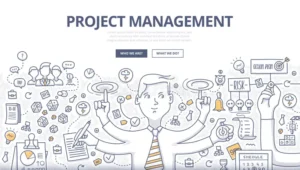 In today’s fast-paced digital landscape, effective IT project management is crucial for success. This comprehensive guide explores the most powerful methods and tools to help you navigate complex IT projects with ease.
In today’s fast-paced digital landscape, effective IT project management is crucial for success. This comprehensive guide explores the most powerful methods and tools to help you navigate complex IT projects with ease.
Traditional vs. Agile: Choosing the Right Approach
When it comes to IT project management, two main approaches dominate the field: traditional and agile methodologies. Each has its strengths and is suited for different types of projects.
Traditional Methods
Traditional methods, such as Waterfall, follow a linear, sequential approach. They’re ideal for projects with well-defined requirements and minimal changes.
Waterfall Method
The Waterfall method guides your project through clear, distinct stages:
- Initiation
- Design
- Implementation
- Verification
- Deployment
This method is particularly useful for large-scale IT infrastructure projects or software development with fixed requirements.
Agile Methods
Agile methodologies emphasize flexibility, collaboration, and rapid iteration. They’re well-suited for projects where requirements may evolve over time.
Scrum: Scrum is an agile framework that breaks projects into short “sprints,” typically lasting 2-4 weeks. It promotes transparency, communication, and continuous improvement.
Kanban: Kanban uses visual boards to represent workflow, helping teams optimize task management and identify bottlenecks. It’s excellent for ongoing IT support and maintenance projects.
Essential IT Project Management Tools
Selecting the right tools can significantly enhance your project management efforts. Here are some top picks for 2024:
1. Asana
Asana is a versatile project management tool that helps teams organize, track, and manage their work. Its features include task assignments, due dates, and customizable dashboards.
2. Jira
Jira is popular among software development teams for its robust issue tracking and agile project management capabilities. It supports Scrum and Kanban methodologies.
3. Trello
Trello‘s intuitive, card-based interface makes it easy to visualize project progress. It’s particularly useful for small to medium-sized IT projects.
4. Microsoft Project
For complex, large-scale IT projects, Microsoft Project offers powerful scheduling and resource management features.
Advanced Techniques for IT Project Success
To take your IT project management to the next level, consider these advanced techniques:
Critical Path Method (CPM)
CPM helps identify the most crucial tasks that directly impact project completion time. It’s invaluable for managing dependencies in complex IT projects.
PERT (Program Evaluation and Review Technique)
PERT is a network chart that represents all tasks and milestones involved in a project. It’s particularly useful for estimating project duration and managing resources in IT initiatives.
Rational Unified Process (RUP)
RUP is a software development framework that helps define project milestones and adapt phases accordingly. It’s designed to optimize the software development lifecycle.
Risk Management in IT Projects
Effective risk management is crucial in IT projects. The Spiral Model, a risk-centric iterative approach, starts each cycle with a deep dive into risk assessment. This method is particularly useful for projects with high levels of uncertainty or where safety is a critical concern.
Managing Remote and Hybrid IT Teams
With the rise of remote work, managing distributed IT teams has become increasingly important. Tools like Slack for communication and GitHub for version control can be integrated with project management software to enhance collaboration and productivity.
Conclusion
Choosing the right combination of IT project management methods and tools is essential for success in 2024 and beyond. By understanding the strengths of each approach and leveraging the most suitable tools, you can streamline your IT projects, improve team efficiency, and deliver high-quality results on time and within budget.Remember, there’s no one-size-fits-all solution. The best approach is to align your chosen methods and tools with your project’s specific requirements, team dynamics, and organizational goals.

Fantastic blog
The list of methods and tools is both comprehensive and practical, offering valuable guidance for IT project managers. Great work!
Nice post. I learn something totally new and challenging